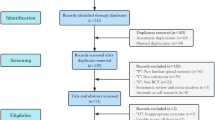Abstract
This is a double blind randomised controlled trial to assess the effectiveness of nasal salmon calcitonin in the treatment of lumbar spinal stenosis. The trial compared the outcome of salmon calcitonin nasal spray to placebo nasal spray in patients with MRI confirmed lumbar spinal stenosis. Lumbar spinal stenosis is one of the commonest conditions encountered by spine surgeons. It more frequently affects elderly patients and lumbar decompression has been used to treat the condition with variable success. Non operative measures have been investigated, but their success ranges from 15% to 43% in patients followed up for 1–5 years (Simotas in Clin Orthop 1(384):153–161, 2001). Salmon calcitonin injections have been investigated in previous trials and may have a treatment effect. Nasal salmon calcitonin has become available and if effective would have advantages over injections. Forty patients with symptoms of neurogenic claudication and MRI proven lumbar spinal stenosis were randomly assigned either nasal salmon calcitonin or placebo nasal spray to use for 4 weeks. This was followed by a ‘washout’ period of 6 weeks, and subsequent treatment with 6 weeks of nasal salmon calcitonin. Standard spine outcome measures including Oswestry disability index (ODI), low back outcome score, visual analogue score and shuttle walking test were administered at baseline, 4, 10 and 16 weeks. Twenty patients received nasal salmon calcitonin and twenty patients received placebo nasal spray. At 4 weeks post treatment there was no statistically significant difference in the outcome measures between the two groups. The change in ODI was a mean 1.3 points for the calcitonin group and 0.6 points for the placebo group (P = 0.51), the mean change in visual analogue score for leg pain was 10 mm in the calcitonin group and 0 mm in the placebo group (P = 0.51). There was no significant difference in walking distance between the two groups, with a mean improvement in walking distance of 21 m in the calcitonin group and 8 m in the placebo group (P = 0.78). At the end of the trial the ODI had improved by a mean of 3.7 points in the calcitonin group and 3.8 points in the placebo group (P = 0.44). This randomised placebo controlled trial has not shown any treatment effect in patients with lumbar spinal stenosis treated with nasal salmon calcitonin.



Similar content being viewed by others
References
Simotas A (2001) Nonoperative treatment for lumbar spinal stenosis. Clin Orthop 1(384):153–161
Porter RW, Hibbert C (1983) Calcitonin treatment for neurogenic claudication. Spine 8(6):585–592
Pratt RK, Fairbank JC, Virr A (2002) The reliability of the Shuttle Walking Test, the Swiss Spinal Stenosis Questionnaire, the Oxford Spinal Stenosis Score, and the Oswestry Disability Index in the assessment of patients with lumbar spinal stenosis. Spine 27(1):84–91
Fairbank J, Pynsent P (2000) The Oswestry Disability Index. Spine 25(22):2940–2953
Greenough CG, Fraser RD (1992) Assessment of outcome in patients with low back pain. Spine 17(1):36–41
Ellerington MC, Hillard TC, Whitcroft SI et al (1996) Intranasal salmon calcitonin for the prevention and treatment of postmenopausal osteoporosis. Calcif Tissue Int 59(1):6–11
Walpin LA, Singer FR (1979) Paget’s disease, reversal of severe paraparesis with calcitonin. Spine 4:213–219
Douglas DL, Duckworth T, Kanis JA et al (1981) Spinal cord dysfunction in Paget’s disease of bone. Has medical treatment a vascular basis? J Bone Joint Surg Br.63B(4):495–503
Podichetty VK, Segal AM, Lieber M, Mazanec DJ (2004) Effectiveness of Salmon calcitonin nasal spray in the treatment of lumbar canal stenosis. Spine 29(21):2343–2349
Porter RW, Miller CG (1988) Neurogenic claudication and root claudication treated with calcitonin. A double-blind trial. Spine 13(9):1061–1064
Streifler J, Hering R, Gadoth N (1989) Calcitonin for pseudoclaudication in lumbar spinal stenosis. J Neurol Neurosurg Psychiatry 52(4):543–544
Eskola A, Pohjolainen T, Alaranta H et al (1992) Calcitonin treatment in lumbar spinal stenosis: a randomized, placebo controlled, double-blind, cross-over study with one year follow-up. Calcif Tissue Int 50:400–403
Onel D, Sari H, Donmez C (1993) Lumbar spinal stenosis: clinical/radiologic therapeutic evaluation in 145 patients: conservative treatment or surgical intervention? Spine 18:291–298
Gennari C (1983) Clinical aspects of calcitonin in pain. Triangle 22(2/3):156–163
Eskola A, Alaranta H, Pohjolainen T et al (1989) Calcitonin treatment in lumbar spinal stenosis: clinical observations. Calcif Tissue Int 45:372–374
Author information
Authors and Affiliations
Corresponding author
Rights and permissions
About this article
Cite this article
Tafazal, S.I., Ng, L. & Sell, P. Randomised placebo-controlled trial on the effectiveness of nasal salmon calcitonin in the treatment of lumbar spinal stenosis. Eur Spine J 16, 207–212 (2007). https://doi.org/10.1007/s00586-006-0154-4
Received:
Accepted:
Published:
Issue Date:
DOI: https://doi.org/10.1007/s00586-006-0154-4




